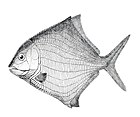| Dicellopyge Temporal range:
| |
|---|---|

| |
| Dicellopyge draperi fossil | |
| Scientific classification | |
| Domain: | Eukaryota |
| Kingdom: | Animalia |
| Phylum: | Chordata |
| Class: | Actinopterygii |
| Order: | †Palaeonisciformes |
| Family: | †Palaeoniscidae |
| Genus: | †Dicellopyge Brough, 1931 |
| Type species | |
| Dicellopyge macrodentata Brough, 1931
| |
| Species | |
| Synonyms | |
| |
Dicellopyge is an extinct genus of freshwater[1] ray-finned fish that lived during the Anisian age of the Middle Triassic epoch in what is now South Africa. It was originally named "Dicellopygae" by James Brough but the name was later corrected to Dicellopyge by Peter Hutchinson.[2]
Dicellopyge coexisted with fish such as Lissodus, Elonichthys, Ceratodus, Coelacanthus, Helichthys, Meidiichthys, and Atopocephala.[1]
Appearance[edit]
It is characterized , for example, by the short, blunt snout and a deeply cleft tail fin. Two species are known, D. draperi (=D. macrodentata) and D. lissocephalus, which were contemporaries and differed in scale and tail fin morphology.
Classification[edit]
It was initially classified in its own family, the Dicellopygidae,[2] but has subsequently been referred to the Palaeoniscidae[3] as a close relative of Acrolepis, Cornuboniscus, Belichthys, and the Amblypteridae.[4]
References[edit]
- ^ a b c Fischer, Jan (2008). "Brief synopsis of the hybodont form taxon Lissodus BROUGH, 1935, with remarks on the environment and associated fauna". Freiberger Forschungshefte. 528 (16): 1–23.
- ^ a b Hutchinson, Peter (1975). "Two Triassic fish from South Africa and Australia, with comments on the evolution of the Chondrostei". Palaeontology. 18 (3): 613–629.
- ^ Poplin, Cecile; Lund, Richard (1997). "Evolution of the premaxillary in the primitive fossil actinopterygians" (PDF). Geodiversitas. 19 (3): 557–565.
- ^ Dietze, Kathrin (2000). "A Revision Of Paramblypterid And Amblypterid Actinopterygians From Upper Carboniferous–Lower Permian Lacustrine Deposits Of Central Europe". Palaeontology. 43 (5): 927–966. Bibcode:2000Palgy..43..927D. doi:10.1111/1475-4983.00156.







